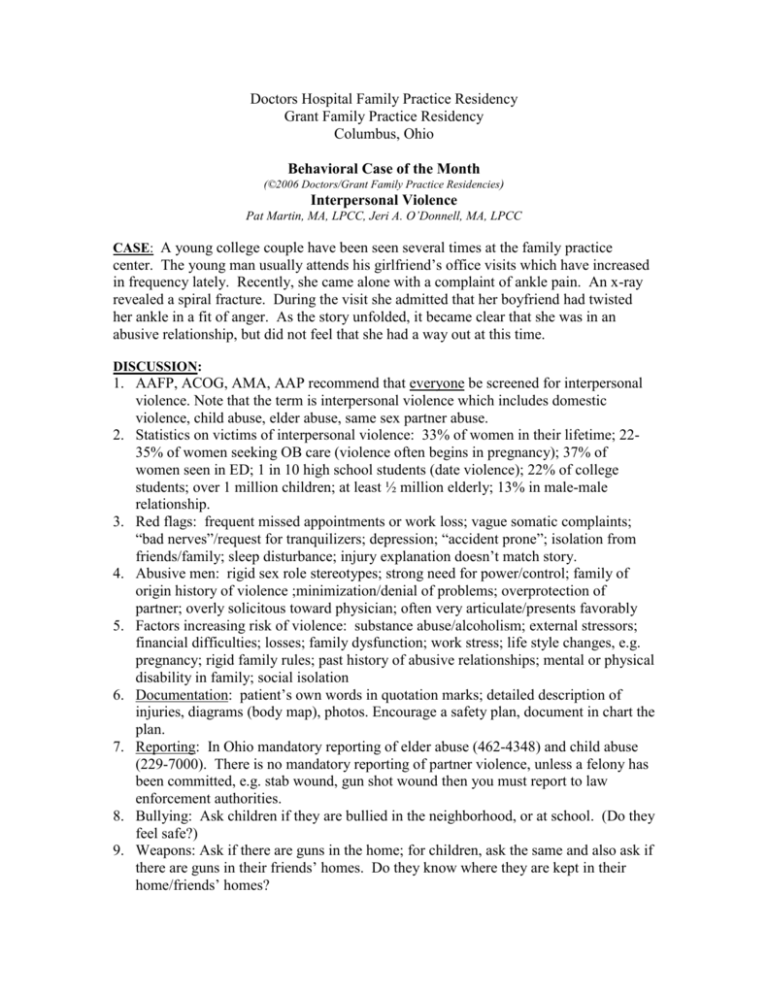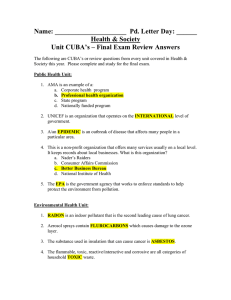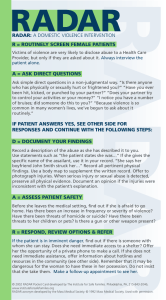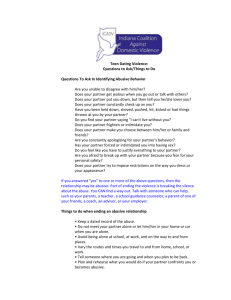Doctors Hospital Family Practice Residency
advertisement

Doctors Hospital Family Practice Residency Grant Family Practice Residency Columbus, Ohio Behavioral Case of the Month (©2006 Doctors/Grant Family Practice Residencies) Interpersonal Violence Pat Martin, MA, LPCC, Jeri A. O’Donnell, MA, LPCC CASE: A young college couple have been seen several times at the family practice center. The young man usually attends his girlfriend’s office visits which have increased in frequency lately. Recently, she came alone with a complaint of ankle pain. An x-ray revealed a spiral fracture. During the visit she admitted that her boyfriend had twisted her ankle in a fit of anger. As the story unfolded, it became clear that she was in an abusive relationship, but did not feel that she had a way out at this time. DISCUSSION: 1. AAFP, ACOG, AMA, AAP recommend that everyone be screened for interpersonal violence. Note that the term is interpersonal violence which includes domestic violence, child abuse, elder abuse, same sex partner abuse. 2. Statistics on victims of interpersonal violence: 33% of women in their lifetime; 2235% of women seeking OB care (violence often begins in pregnancy); 37% of women seen in ED; 1 in 10 high school students (date violence); 22% of college students; over 1 million children; at least ½ million elderly; 13% in male-male relationship. 3. Red flags: frequent missed appointments or work loss; vague somatic complaints; “bad nerves”/request for tranquilizers; depression; “accident prone”; isolation from friends/family; sleep disturbance; injury explanation doesn’t match story. 4. Abusive men: rigid sex role stereotypes; strong need for power/control; family of origin history of violence ;minimization/denial of problems; overprotection of partner; overly solicitous toward physician; often very articulate/presents favorably 5. Factors increasing risk of violence: substance abuse/alcoholism; external stressors; financial difficulties; losses; family dysfunction; work stress; life style changes, e.g. pregnancy; rigid family rules; past history of abusive relationships; mental or physical disability in family; social isolation 6. Documentation: patient’s own words in quotation marks; detailed description of injuries, diagrams (body map), photos. Encourage a safety plan, document in chart the plan. 7. Reporting: In Ohio mandatory reporting of elder abuse (462-4348) and child abuse (229-7000). There is no mandatory reporting of partner violence, unless a felony has been committed, e.g. stab wound, gun shot wound then you must report to law enforcement authorities. 8. Bullying: Ask children if they are bullied in the neighborhood, or at school. (Do they feel safe?) 9. Weapons: Ask if there are guns in the home; for children, ask the same and also ask if there are guns in their friends’ homes. Do they know where they are kept in their home/friends’ homes? RESOURCES: 1. Screening tools: You can ease into this discussion by asking how they resolve conflicts; how they and their partner deal with frustration/anger. H.I.T.S.: How often does your partner hurt, insult, threaten, swear or curse at you. PVS: Have you been hit, kicked, punched or otherwise hurt by someone in the past year? Who? Do you feel safe in current relationship? Is there a partner from previous relationship making you feel unsafe now? 2. Resources: CHOICES (shelter for women and their children, counseling) 2244663, 24 hr. hotline; Columbus City Prosecutors Office 645-7483; Legal Aid Society of Columbus 241-2001 or 645-1597; BRAVO 294-7867 (Gary) same sex partner violence. 3. Websites for more information: www.womenslaw.org/OH/OHhow to.htm www.odvn.org; www.sexualityandu.ca/eng/includes/health/pdf/wasttool.pdf www.ohioafp.org/members/resourcesreferences/domesticviolence/DV-Screening tool.pdf www.uihealthcare.com/depts/med/familymedicine/reserach/geriatrics/eldermistre atment/partner.pdf www.femalepatient.com/html/arc/sig/screening/articles/029 04 039.asp www.bravo-ohio.org.











